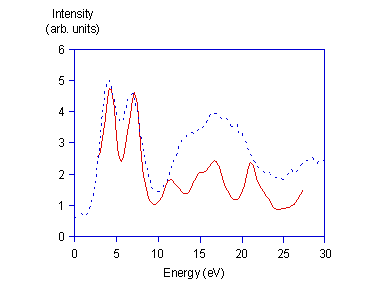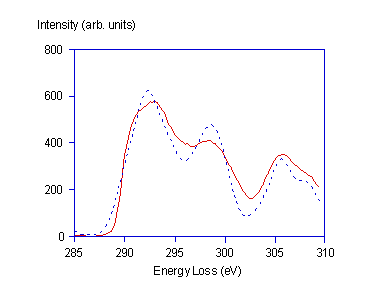
LKKR calculation for O K edge in TiO2Solid line calculation, dashed line experiment

Pseudopotential calculation for C K edge in diamond, solid line experiment.
Electrons interact strongly with matter. Even in a transmission electron microscope specimen, which is only 100nm thick, the high voltage microscope electrons are scattered many times. Electrons can be scattered elastically (no energy lost to the specimen) or inelastically. I have been involved in the development of theories to describe mixed elastic-inelastic scattering, procedures for calculating the electron scattering potential, and theories appropriate for new imaging modes such as High Angle Annular Dark Field (HAADF) imaging. Recently I have been consulting with Halcyon Molecular on resurrecting an old idea: using electron microscopy to sequence DNA.
Electron Energy Loss Spectroscopy and Near Edge Fine Structure Analysis When fast electrons (50kV-1MV) pass through a transmission electron microscope specimen they can loose energy by exciting electrons associated with atoms in the spectrum. The distribution of transmitted electrons as a function of energy loss is called an energy loss spectrum. There are sharp increases in intensity known as an inner shell edges when the energy loss is equal to the binding energy of an inner shell electron. These features can be used for microanalysis, and in my earlier work I used various atomic physics (Hartree-Fock-Slater, Dirac-Fock) programs to calculate appropriate ionisation cross sections. I am now more interested in understanding the near edge structure and using it to give information about bonding, coordination and charge transfer on an atomic scale. I have been applying various approaches based on modern electronic structure techniques (Full Potential Linearised Augmented Plane Wave (FLAPW), Layer Korringa Kohn Rostoker (LKKR), Pseudopotential) to the calculation of the densities of unoccupied states and the resulting near edge fine structures.
Reference: The Theory and Interpretation of Electron Energy Loss Near-Edge Fine Structure P. Rez and D.A. Muller, Annual Reviews of Materials Research,38, 18:1 -18:24, (2009)
Past Graduate Students Involved in This Work: X. Weng, J. Auerhammer,
J. Alvarez

LKKR calculation for O K edge in TiO2Solid line calculation, dashed line experiment |

Pseudopotential calculation for C K edge in diamond, solid line experiment. |
In Situ Growth of Carbon Nanotubes we grow nanotubes in the Environmental TEM from nano catalyst particles.
The aim is to grow nanotubes at defined positions with control over length diamter and chirality.
In collaboration with Dr. Renu Sharma and Prof. Mike Treacy
Funded by NSF
